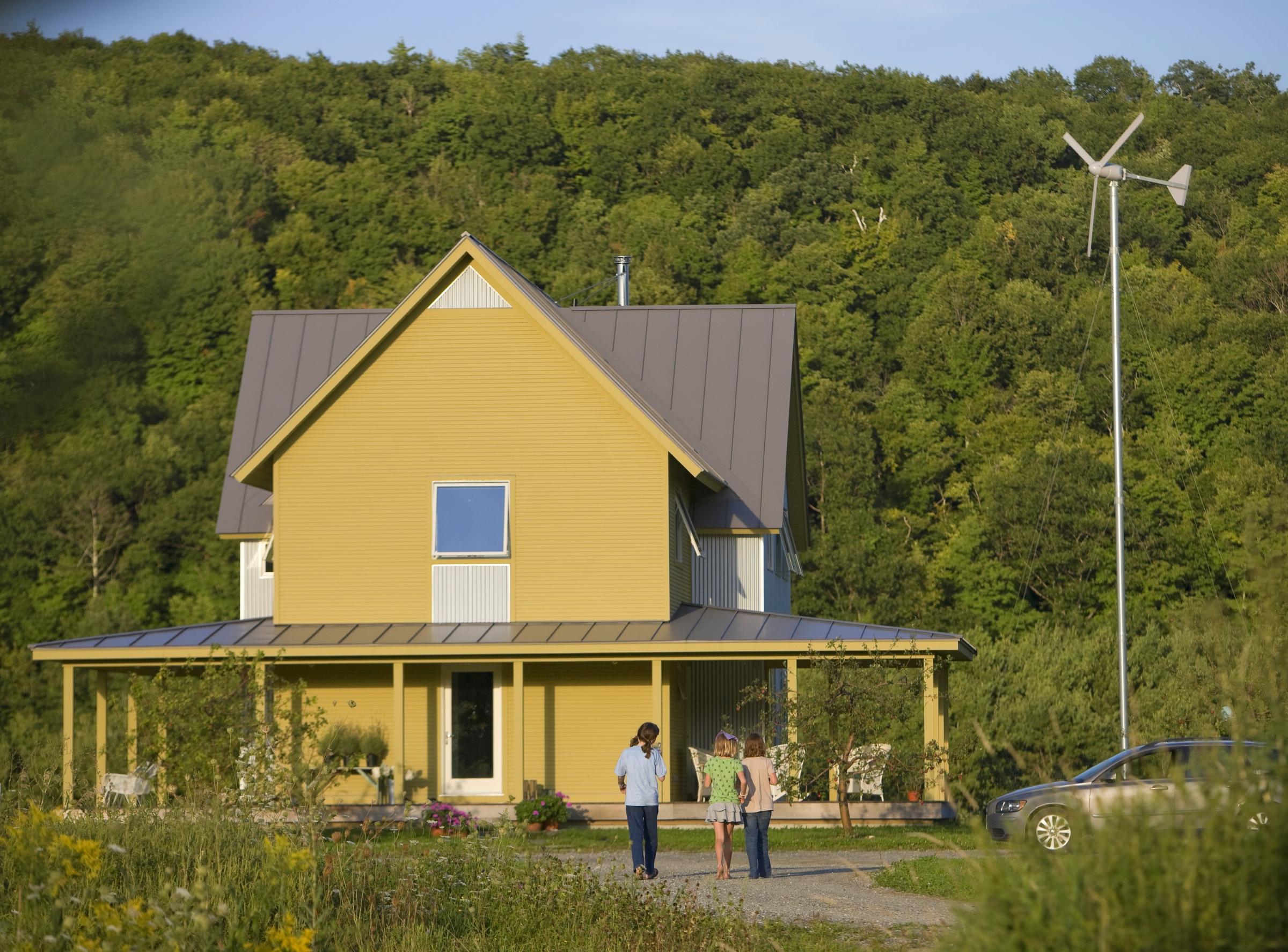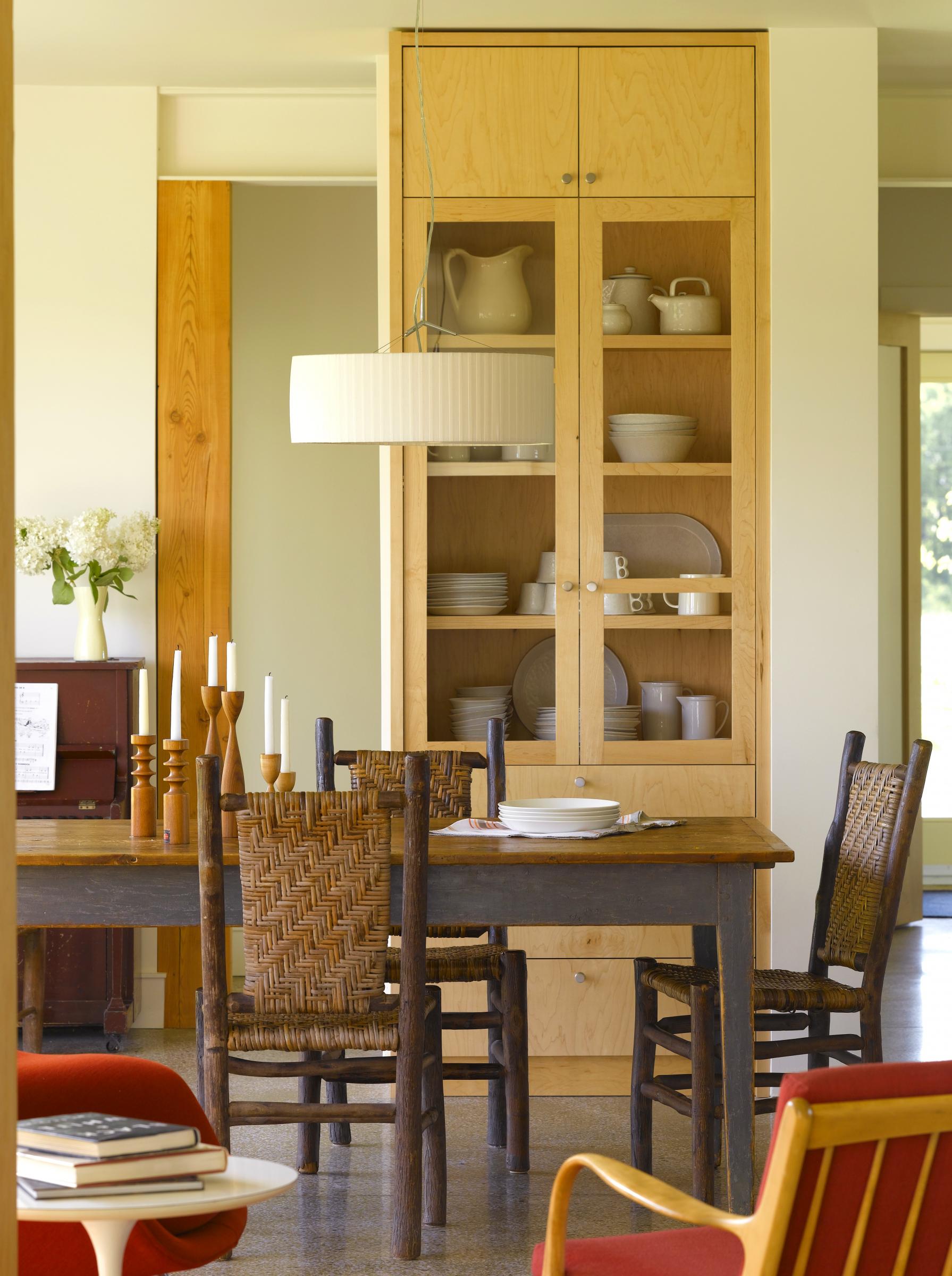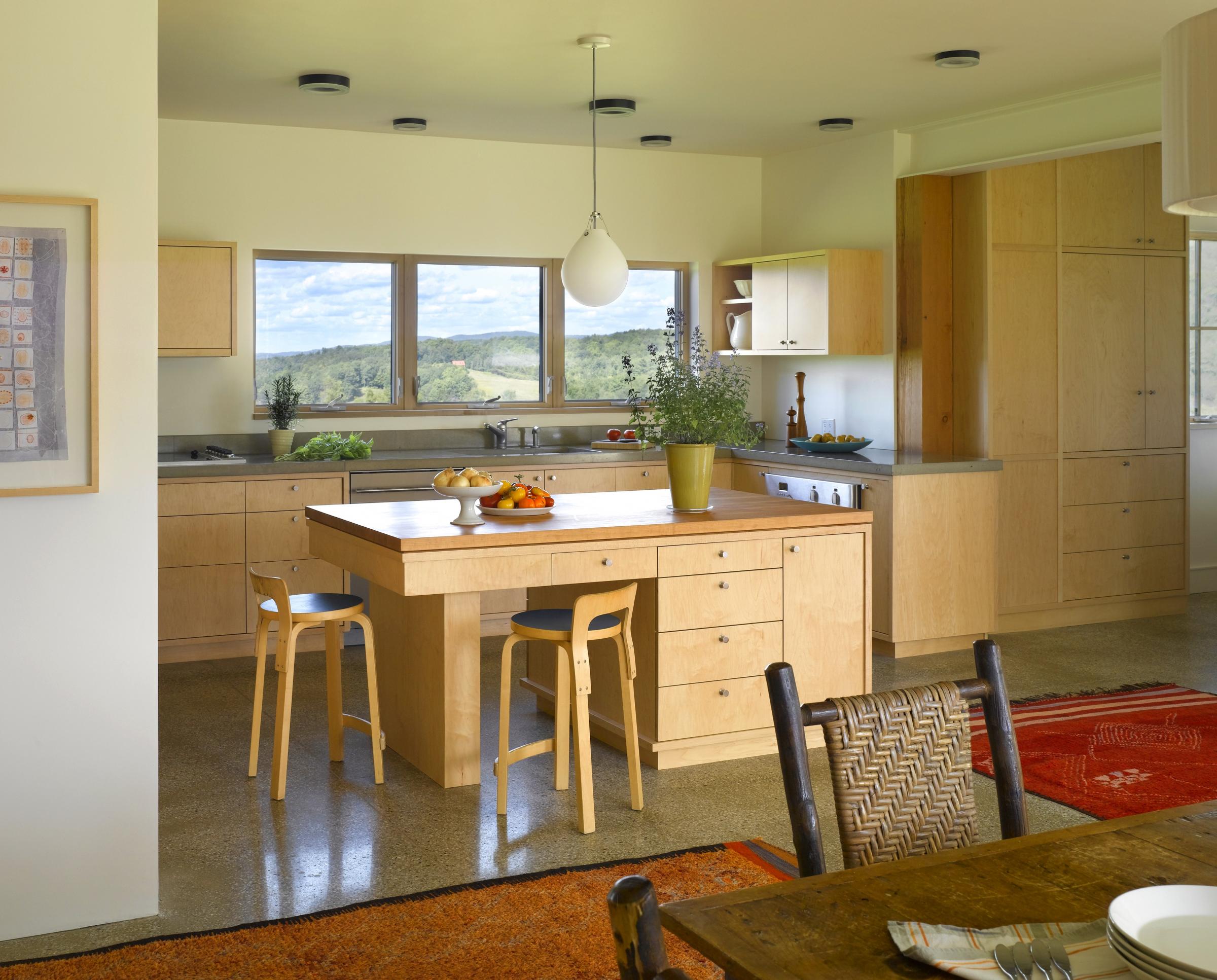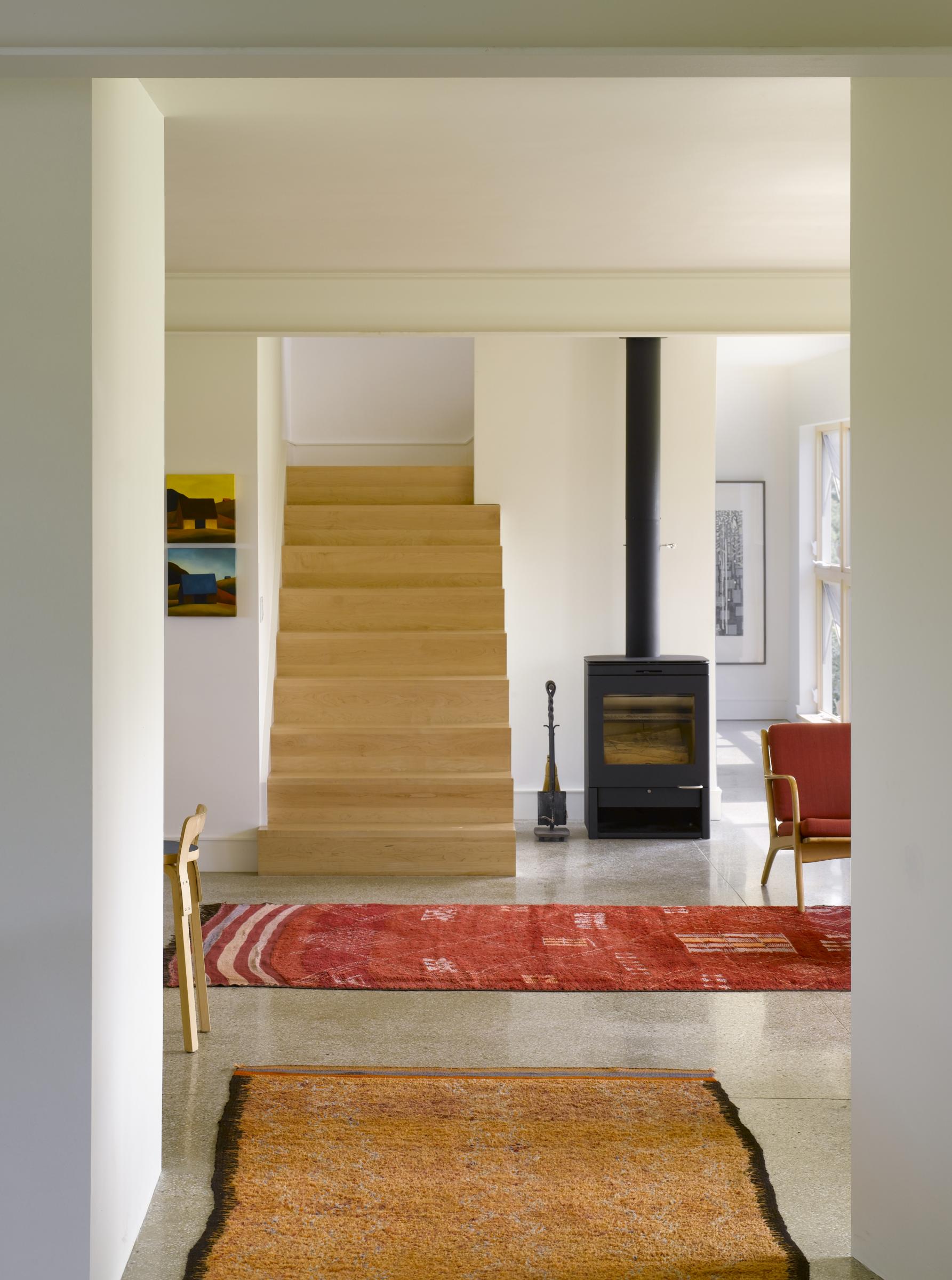Project Subtitle:
Project Description:
This is a 2800 SF single family residence for a family of four located in East Charlotte, VT. The house was completed August 1st 2007 The goal was to create a house with as little environmental impact as possible while maintaining a high level of design and detail in a cold northern climate. The house has been designed to, and has been functioning for the last 9 years( since completed) at net zero energy use with zero carbon emissions, using only electricity generated on site with its 10KW net-metered wind turbine and 5kW PV tracker (added in 2010). Since built the house has been net positive putting 4000 kWh back into the grid. Being in a rural Vermont landscape we designed the house by taking cues from the local agricultural context. The exterior form expresses the simplicity found in barns and farm houses, allowing us to create a simple building envelope which was more efficient to build and to heat. The interior was designed with a clean minimal aesthetic allowing focus to the carefully framed views out into the landscape. The design of the house is large enough for a family of four with future flexibility, and small enough to limit energy use and resources.
Project Description
The house maximizes energy efficiency by being long and narrow on the true east west axis with simple massing. It is a super insulated passive solar design which uses a ground source heat pump for all heating and domestic hot water; the finished floor on the first level is a 4” ground and polished concrete slab for thermal mass and the open plan allows for flexibility as well as southern daylight into all living spaces. The 10KW net-metered wind turbine produces all of the electricity required for heating, hot water, cooking, lighting and appliances. No fossil fuels are used. Using an integrated design approach, involving the architect/client, energy consultant, structural engineer and the builder allowed us to coordinate all of these strategies into a moderately priced net zero house which maintains a high level of design and detail.
Building Type Summary:
Other Awards:
2008 AIA VT Honor award
2009 SBIC High Performance Building award
2008 Effficiency Vermont Best of the Best Honor Award
2012 Vermont Green Building Network Net Zero award and Vermont's Greenest Building Award
Address:
Elevation:
Lat. / Long.:
Location Type:
Climate Region:
Solar Insolation:
Annual HDD :
Occupancy Type and Details:
Family of 4
Conditioned Floor Area:
Semiconditioned Floor Area:
Unconditioned Floor Area:
Multiple buildings?:
Total number of units in project (all buildings):
Total floor area of project (all buildings):
Historic?:
Completion date:
Site description:
Rural site with an existing 14,000 SF riding arena, horse stalls and residence. Building was disassembled and re-built a 1/4 mile away. New home constructed on the already disturbed land.
Materials:
Triple glazed windows U = .17
FSC certified wood
Cedar clapboard
Metal siding - durability
Metal roofing - durability
Materials from local sources
Concrete counters locally crafted
Local sustainably harvested maple flooring and hardwoods for cabinetry
Butcher block counter locally harvested and crafted
Reclaimed fir columns
Cellulose insulation
Denim insulation
Closed cell spray foam insulation
Low/no V.O.C. paints and finishes
Energy Highlights:
High performance envelope with passive solar strategies combined with renewable energy generation and an EV charging station added in 2014. This allows occupants to use renewable energy generated on site to drive approx. 8000 miles per year and still be a net producer of energy
HERS Index:
Annual renewable energy generated:
Electric Utility Company:
Datasets and Utility Bills sources and reliability:
100% reliable from utility bills, although varies from year to year. Information given is the average of the last few years with an electric car driven approx 8000 miles per year for commuting
Electricity amount (imported from grid):
Electricity amount (credited or exported to grid):
Net electricity usage (purchased electricity):
Subslab assembly:
4" of EPS wrapped up to isolate 4" conc slab
Slab edge assembly:
2" EPS
Foundation wall assembly:
From exterior to interior - 8" of concrete, 2" of EPS 2x4 dense pack cellulose
Above grade wall assembly:
2 x 6 studs with closed cell foam with 1.5" of continuous rigid insulation on the exterior.
Cathedral ceiling assembly:
Attic 2x12 rafters filled with closed cell foam
Door Area:
Space heating - Manufacturer & Model:
Space heating - capacity:
Domestic hot water - Manufacturer & Model:
Domestic hot water - capacity:
Ventilation - Manufacturer & Model:
Total Cost of Project:
Gross Cost of Renewable Energy System:
Value of Tax Credits for renewable energy systems:
Net Cost of renewable energy systems:
State incentives:
Vermont Renewable Energy Resource Center - $12,500 incentive for small wind
Utility incentives:
Net metering
Annual Electric Savings:
Annual Revenue from SRECs or other renewable energy credits:
NESEA Awards:
2009 Won the first Net Zero NESEA prize
Published References:
Northeast Sun
Design New England Magazine
Journal of Light construction Magazine
Fine Home Building Magazine
Toward a Zero Energy Home - Book
Home Sweet Zero Energy Home - Book
Special architectural measures:
This project uses daylighitng, passive solar combined with thermal mass, super insulation, ground source heat pump and a 10kW wind turbine/4kW PV to be a net producer including the use of an all electric car for commuting
Energy Strategies:
The house maximizes energy efficiency by being long and narrow on the true east west axis with simple massing. It is a super insulated passive solar design which uses a ground source heat pump for all heating and domestic hot water; the finished floor on the first level is a 4” ground and polished concrete slab for thermal mass and the open plan allows for flexibility as well as southern daylight into all living spaces. The 10KW net-metered wind turbine produces all of the electricity required for heating, hot water, cooking, lighting and appliances. No fossil fuels are used
Subslab R-value:
Slab edge R-value:
Foundation wall R-value:
Above grade wall R-value:
Cathedral ceiling R-value:
Average window U-factor:
Solar Heat Gain Coefficient:
Visible Light Transmittance:
Cost per square foot of Conditioned Space:
Air Changes per hour, ACH50:
Project Photos:





Number of Bathrooms:
Site conditions:
Renewable Energy Sources:
Summary of enclosure strategy/description:
The house was conventionally framed with 2 x 6 studs with closed cell spray foam, with rigid insulation on the exterior, creating a thermal bridge free wall system. Air barrier on the exterior. All plates and double studs caulked. Roof -2x12 rafters filled with closed cell spray foam
Roof R-value:
Window Description:
Thermotech fiberglass windows
Door Description:
Thermatru doors fiberglass.
Number of Bedrooms:
Project Team:
Team Member:
Team Member:
Team Members:
Jim Huntington - Builder
John Higgins - Structural Engineer

Mechanical Equipment Installation Details and Comments:
System was designed by an engineer, third party tested. HRV was tested with Flow hood, blower door was performed.